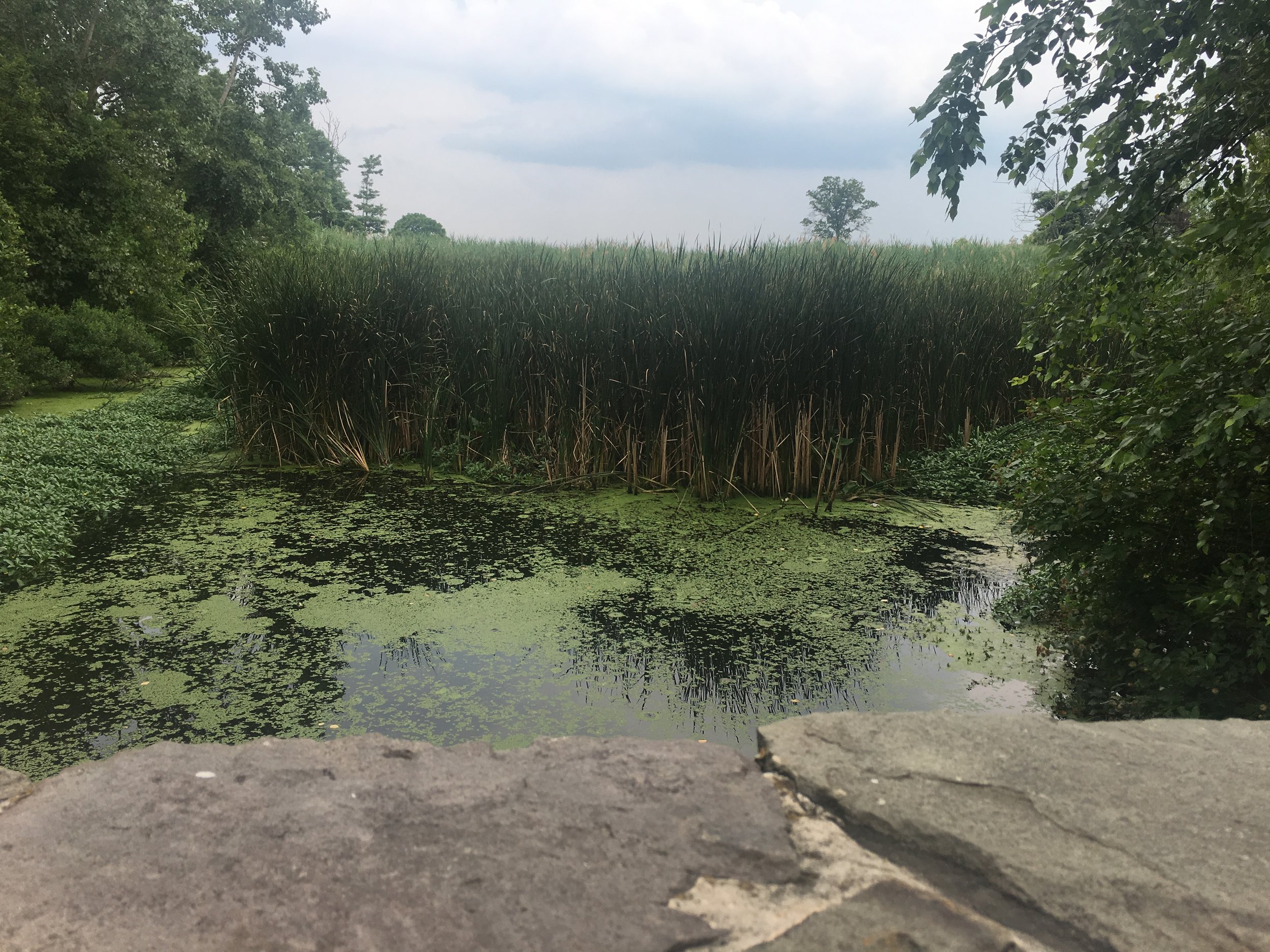Exploring Aquaculture in Tottenville
On July 13, 2017, we met with David Berg of the Long Island Regional Planning Council (LIRPC) and John Kilcullen, Director of Conference House Park, to explore the possibility of siting an aquaculture farm off the Tottenville shoreline. The LIRPC will be issuing a Request for Proposals (RFP) to examine the feasibility of expanding commercial shellfish aquaculture, and of developing seaweed aquaculture, as a means of removing nitrogen from New York's marine waters (bioextraction). He was looking for a New York City site and was intrigued by the possibilities of the Tottenville shoreline, where there were already plans for some experimenting with oyster cultivation as part of the future Living Breakwaters project.
John Kilcullen points out to David Berg the current locations along Staten Island's south shore of The Harbor School's Billion Oyster project.
The goal of the Long Island Nitrogen Action Plan is to ameliorate the toxic algae blooms and incidents of fish kills resulting from increasingly high levels of nitrogen found in Long Island’s and New York City’s marine waterways. The prime culprits are known to be wastewater, atmospheric deposition from coal and auto exhaust, seepage from contaminated groundwater, and runoff from agricultural and residential fertilizers. This escalating nitrogen crisis is now high on the radar screen of New York State elected officials, not only because of the environmental impacts, but also because of the adverse impacts on the state’s recreational and tourism economies and on the real estate values of contiguous properties.
The Nitrogen Action Plan is seeking insights into the barriers to, and opportunities for, shellfish and seaweed aquaculture. Shellfish being considered for cultivation include oysters, clams and ribbed mussels—the latter of interest because they are not grown for human consumption and can therefore be grown in New York City’s uncertified waters. Sugar kelp, which can be grown beginning in November and harvested in May and June, thus not interfering with water sporting activities in contiguous waters, is a likely candidate for seaweed aquaculture.
We walk along the Conference House Park shoreline to view possible site for the Tottenville acquaculture farm.
Here are some of the questions that the Nitrogen Action Plan hopes to address:
- Although shellfish cultivation in waters certified safe for human consumption has proven to be economical, is there a viable economic model for growing shellfish (perhaps to sub-market size) in New York City’s uncertified waters and could it even be permitted?
- Could seaweed be grown and harvested profitably for fertilizer or livestock food if it cannot be grown for human consumption?
- What varieties of seaweed other than sugar kelp can be grown successfully off the waters of Long Island Sound, Westchester, and New York Harbor?
- What is the optimal size of a seaweed farm?
- Can seaweed be grown safely for human consumption in uncertified waters? (A pilot seaweed farm in the East River met European Certification standards but there is currently no official such certification standard in New York.)
- Could a nitrogen trading system for the State of New York, if instituted, provide income to aquaculture farmers providing bioextraction services?
- Would there be a profitable market for relayed shellfish or potentially seaweed, that is, shellfish and seaweed grown in uncertified waters and later removed before harvesting to cleaner waters where natural processes would purge them of impurities? Could permits be secured for such an operation?
- Might municipalities pay aquaculture farmers to grow seaweed and shellfish for bioextraction as an alternative to the costly construction of sewage treatment plants?
Restored wetlands at Conference House Park.
John Kilcullen, Director of Conference House Park, noted that high levels of nitrogen similar to that experienced by Long Island's embayments also plague Staten Island’s Raritan Bay. He reported that the scientific and policy inquiries to be undertaken by the Nitrogen Action Plan were closely aligned with the Conference House Park’s educational mission and he welcomed the possible collaboration.
After we toured the shoreline of Conference House Park, we parted company for the day on a note of optimism. Dave concluded that there is indeed potential for shellfish and/or seaweed aquaculture for nitrogen removal in Tottenville, although he admits there will be challenges moving forward, though he expects that the team selected from the RFP will provide answers. One of the next steps will be to learn more about the work of the Harbor School. It is a New York City public high school on Governor’s Island devoted to training students to participate in the maritime economy. The Harbor School is already cultivating oysters with Staten Island schools off the shores of Great Kills and Prince’s Bay as part of its Billion Oyster Project.
We were all excited about supporting the return of aquaculture to New York City’s waters. To be further inspired, Dave suggested we all read The Big Oyster, by Mark Kurlansky, which chronicles the storied role shellfish have played in the city’s economic and cultural history. Of course we already knew about the role it has played in Tottenville’s history, thanks to Barnett Shepherd and his book The Town the Oyster Built.
Related sources & articles:
Meet the Women of California's First Open-Water Seaweed Farm
Schematic of shoreline stewardship projects envisioned for the Living Breakwaters project. Photo credit: Scape Studio.




